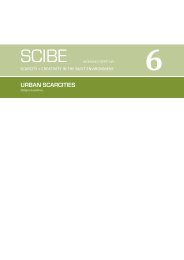SOME THOUGHTS ABOUT SCARCITY - SCIBE
SOME THOUGHTS ABOUT SCARCITY - SCIBE
SOME THOUGHTS ABOUT SCARCITY - SCIBE
Create successful ePaper yourself
Turn your PDF publications into a flip-book with our unique Google optimized e-Paper software.
7<br />
<strong>SOME</strong> <strong>THOUGHTS</strong> <strong>ABOUT</strong> <strong>SCARCITY</strong><br />
If we add to this the reasons for one or another scarcity our challenges<br />
become more varied. What is demanded of a situation where there is an<br />
overall shortage of units and need for many dwellings, as for example at the<br />
end of each of the world wars, is different from the challenges raised by<br />
market based housing where there may be no overall shortage of units but a<br />
shortfall of units at a given cost usually low-cost. In the South, the challenges<br />
posed by housing scarcity is more often an issue of the availability of formal<br />
and conventional housing and not dwellings per se. More often too is the<br />
issue not so much of a general shortfall but where housing for different<br />
groups is located. And most critically, how one might respond to often<br />
housing shortages, whether in the North or South, is a function not only of<br />
the type of shortage but whether responses are limited by the political will<br />
to address the shortage or significant technical issues associated with any<br />
housing upgrade or provision.<br />
To speak of scarcity in relation to creativity in housing design then is<br />
neither straightforward. Depending on the scarcity referenced and the<br />
social and economic conditions in which this scarcity is found , what needs<br />
to be addressed in the design of housing will be significantly different. Take<br />
for example addressing the housing shortages and challenges associated<br />
with the development of slums. For the most part slums, it is commonly<br />
argued (UN Habitat Slum Book), are the result of some kind of scarcity be it<br />
of affordable housing, or housing in general. But depending on the type of<br />
slum and the type of housing that is being included in our assessment, the<br />
design issues will vary radically.<br />
‘Slums’ are found in many shapes, sizes and locations and with a variety<br />
of legal and socially accepted types of tenure. Many slums were and in some<br />
case still are found in the central part of our cities. They may be the result of<br />
direct investment in cheap but profitable housing by wealthy landlords<br />
seeking a maximum profit as they were in many of the notorious slums of<br />
cities like London, Manchester and New York. St. Giles Rookery described by<br />
Dickens was such a slum as was the infamous neighbourhood of Five Points




